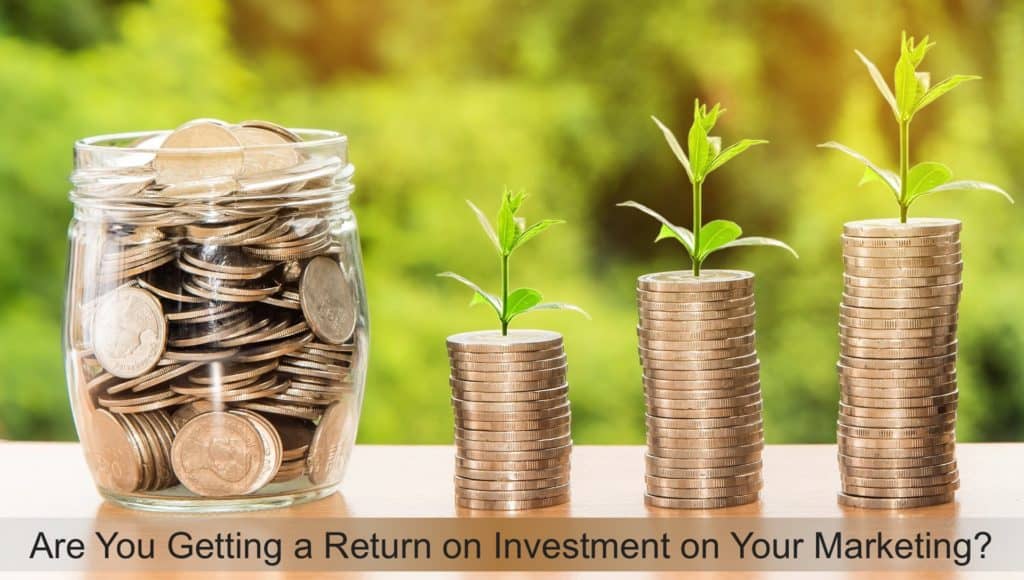
Return on investment (ROI). It’s something you expect to hear when you invest your money in stock, bonds, or mutual funds but not necessarily when it comes to your marketing.
For many, marketing is just another cost of doing business. Costs don’t tend to give you a return. You’ve likely never bought a twinkie and woke up the next morning to find that one twinkie became two overnight. If this does happen, I would highly recommend not eating either because that’s a warning sign.
If you already see marketing as an investment, I have a couple of questions for you. What are you investing? And, what do you want for a return?
If you see marketing as a cost, I’m going to challenge your thinking today because you really should be getting a return on your marketing. However, you may need to readjust your thinking.
In either case, I invite you to read on.
Is Your Marketing a Cost or an Investment?
How you view marketing is important because perception is powerful. It has an impact on how you feel about it and what it can do for your business.
It’s either a cost or it’s an investment.
Let’s talk about cost first.
Costs are transactional. You exchange something for a product or service. Typically that something is money.
Most of what we do is transactional in nature. Getting gas for your car. Buying groceries (or twinkies). The subscription to Netflix, Spotify, or Hulu. Your Amazon Prime membership.
You exchange your money to get something in return.
Investing is a little different. When you invest in something you’re expending something, again typically money, to make a profit at some point.
This means you want to see growth.
When you buy gas for your car, you won’t come outside in a week to find that the 10 gallons you bought has turned into 10.3 gallons.
When you buy stock or put money in a mutual fund, there is an expectation that you’re going to get more money back than you initially put in.
To make this simple, if you view marketing as a cost, you’re viewing it with a transactional mentality. It’s something that is just another line on the ledger of what you’re spending.
If you view marketing as an investment, you’re viewing it with a growth mentality. You’re spending money to make more money in the long term.
Why Should You Care About ROI?
One of the biggest reasons you should care about the ROI of your marketing is because you’re boss or client cares about it.
Nobody invests with the idea that they are going to break even or lose money. People invest money to make money. The return is the reason why you are investing and the bigger the return the better.
The second reason you should care about ROI is it shows the impact of your marketing efforts. In other words, the investment in your marketing needs to show results that are measurable.
Before you invest in marketing, you need to be clear on what your goals are. After all, it’s the reason for the investment in the first place.
Any marketing or public relations (PR) that you are doing should always tie back to the goals of your business.
Don’t subscribe to the hope method where you do a bunch of marketing and hope that it works out.
Be strategic and have a plan. If you don’t, it’s more likely than not that you won’t see any ROI. It’s also a sign that you really see marketing as a cost.
Why Are You Investing?
The easy answer is money. After all, it does make the world go around.
However, there are many reasons why you could be investing in marketing and PR outside of money.
You might want to build relationships with people that could lead to them to doing business with you somewhere down the line.
Trust is always important in any business relationship so a goal of your marketing could be to build credibility with potential prospects.
Maybe, you want to be recognized as a thought leader in your industry. The person that people come to when they have questions.
Building affinity is always good. Dare I say, it’s more important than loyalty. If people don’t like you or your product it’s likely they will never do business with you.
Creating awareness is importanta as well. If people don’t know that your business or the products you are selling exist, they are never going to buy from you.
I can’t leave out driving traffic. If you have a website or a physical location, you need people to visit. If they aren’t visiting it’s impossible to sell anything.
These are all things that your marketing and PR can impact. If you do it in a positive way, meaning good marketing and PR, it’s likely that doing them will create opportunities for you to make money.
Not necessarily now but in the future.
The bottom line is, you need to know why you’re investing. Both in the short and long term.
What Are You Investing?
There are only two things you can invest. Yes, you read that right. Two.
Money is the obvious one. I’ll talk about that more in a minute but you are also investing time.
Time is overlooked but it’s important. It’s a limited resource. Regardless of how big your company is or how much it makes, there are only 24 hours in a day.
The time you spend engaging in marketing is part of what helps you get a return on your investment.
Writing an article. Shooting a video. Creating a landing page. Posting to social media. Pitching an article to the media. Updating your website. These all require time.
When you outsource these things, it’s likely partially based on a desire to use your time in a different way.
However, when you outsource, you’re spending money.
Ads are one of the most obvious marketing activities that cost money. They can come in many different forms such as banner ads, social media ads, or search ads on Google.
Even your presence on a free platform may cost you money to get anything worthwhile out of it.
Facebook is one of these platforms. For all practical purposes, unless Facebook makes some changes to its algorithm, it is a paid platform for businesses. This means if you want results on Facebook, you have to run ads.
Understanding whether you are investing your time or your money is important. Especially when it comes to ROI.
If you don’t know how much time you are investing, it’s hard to calculate ROI.
It’s the same with money but chances are you’re paying more attention to it than time.
You Need To Measure
The only way to know how your marketing investment is doing is to measure.
There are many different things that you can measure that will show you how your marketing is progressing.
Be wary of vanity metrics. These are things such as follower counts or the number of likes. Don’t let them become ego boosters. Look at them as indicators that there is interest and determine how to build on that interest.
You need to make sure that you are measuring the right things.
For example, if you’re sharing links in your social media posts, rather than focus on likes, a much better metric is the click-through rate (CTR). At the end of the day, you want to move people from the social platforms to your owned media which is your website or email list.
However, this does depend on what your goals are. Make sure the metrics you are using are showing real progress towards those goals.
Your marketing is like an investment portfolio. It is made of multiple investments in the areas of paid media, earned media, share media, and owned media (better known as the PESO model created by Gini Dietrich at Spin Sucks). They are all separate but they do work together.
Attribution is Important
Like with any investment portfolio, you want to look at the different pieces and see how they are performing. You do this to determine which investments are getting you the best bang for your buck. It can also be a guide as far where to invest more, where to invest less, and where to cash out.
This is another of saying you need to be able to see what pieces of marketing are driving not only macro conversions such as purchase but micro conversions such as somebody putting an item in their basket.
Every piece of your marketing can be broke down. Your website has many different pieces to it. Understanding how each pieces is contributing to a conversion is important.
Again, it not only shows how your investment is doing but those areas that might need to be adjusted.
Final Thoughts
You should be getting ROI for your marketing. I don’t feel that’s up for debate.
There are many things that can impact your marketing and whether you are getting ROI. Your viewpoint is one of those things.
If you want to focus on getting a good return on investment, the choice is clear. Marketing isn’t a cost, it truly is an investment.
Image by Nattanan Kanchanaprat from Pixabay
- Is Your Marketing Connected? - March 6, 2025
- Stop Planning and Start Strategizing - October 24, 2024
- The Importance of Creating a Connection With Your Marketing - June 6, 2024

